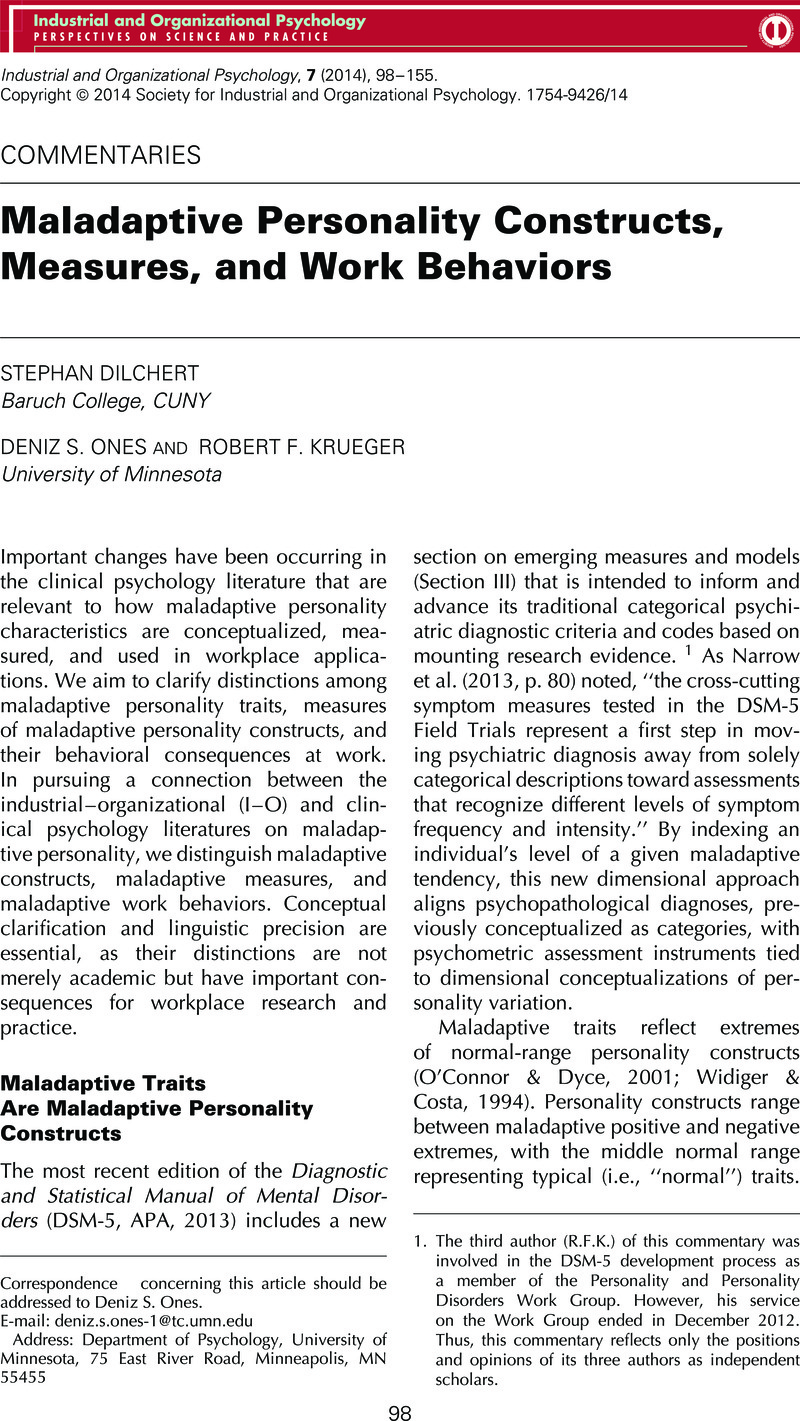Crossref Citations
This article has been cited by the following publications. This list is generated based on data provided by Crossref.
Viswesvaran, Chockalingam
Ones, Deniz S.
Schmidt, Frank L.
Le, Huy
and
Oh, In-Sue
2014.
Measurement Error Obfuscates Scientific Knowledge: Path to Cumulative Knowledge Requires Corrections for Unreliability and Psychometric Meta-Analyses.
Industrial and Organizational Psychology,
Vol. 7,
Issue. 4,
p.
507.
Viswesvaran, Chockalingam
Ones, Deniz S.
Schmidt, Frank L.
Le, Huy
and
Oh, In-Sue
2014.
Measurement Error Obfuscates Scientific Knowledge: Path to Cumulative Knowledge Requires Corrections for Unreliability and Psychometric Meta-Analyses.
Industrial and Organizational Psychology,
Vol. 7,
Issue. 4,
p.
507.
Schyns, Birgit
2015.
Dark Personality in the Workplace: Introduction to the Special Issue.
Applied Psychology,
Vol. 64,
Issue. 1,
p.
1.
Guenole, Nigel
2015.
The Hierarchical Structure of Work-Related Maladaptive Personality Traits.
European Journal of Psychological Assessment,
Vol. 31,
Issue. 2,
p.
83.
Knežević, Goran
Lazarević, Ljiljana B.
Bosnjak, Michael
Purić, Danka
Petrović, Boban
Teovanović, Predrag
Opačić, Goran
and
Bodroža, Bojana
2016.
Towards a personality model encompassing a Disintegration factor separate from the Big Five traits: A meta-analysis of the empirical evidence.
Personality and Individual Differences,
Vol. 95,
Issue. ,
p.
214.
Lazarević, Ljiljana B.
Bošnjak, Michael
Knežević, Goran
Petrović, Boban
Purić, Danka
Teovanović, Predrag
Opačić, Goran
and
Bodroža, Bojana
2016.
Disintegration as an Additional Trait in the Psychobiological Model of Personality.
Zeitschrift für Psychologie,
Vol. 224,
Issue. 3,
p.
204.
Viswesvaran, Chockalingam
and
Ones, Deniz S.
2016.
The Wiley Handbook of Personality Assessment.
p.
59.
Wiernik, Brenton M.
and
Ones, Deniz S.
2018.
Ethical employee behaviors in the consensus taxonomy of counterproductive work behaviors.
International Journal of Selection and Assessment,
Vol. 26,
Issue. 1,
p.
36.
Smith, Mickey B.
Hill, Aaron D.
Wallace, J. Craig
Recendes, Tessa
and
Judge, Timothy A.
2018.
Upsides to Dark and Downsides to Bright Personality: A Multidomain Review and Future Research Agenda.
Journal of Management,
Vol. 44,
Issue. 1,
p.
191.
Donahue, John J.
and
Thompson, Rebecca J.
2019.
General and clinical personality assessment in workplace settings: Lines in the sand or regions on the beach?.
Industrial and Organizational Psychology,
Vol. 12,
Issue. 2,
p.
190.
Zhang, Don C.
Highhouse, Scott
and
Nye, Christopher D.
2019.
Development and validation of the General Risk Propensity Scale (GRiPS).
Journal of Behavioral Decision Making,
Vol. 32,
Issue. 2,
p.
152.
Dilchert, Stephan
Ones, Deniz S.
and
Krueger, Robert F.
2019.
Personality assessment for work: Legal, I-O, and clinical perspective.
Industrial and Organizational Psychology,
Vol. 12,
Issue. 2,
p.
143.
Wiernik, Brenton M.
Bornovalova, Marina A.
Stark, Stephen E.
and
Ones, Deniz S.
2019.
Constructs versus measures in personality and other domains: What distinguishes normal and clinical?.
Industrial and Organizational Psychology,
Vol. 12,
Issue. 2,
p.
157.
Castille, Christopher M.
Castille, Ann-Marie R.
and
Williamson Smith, Rachel
2019.
Assessing ideal personalities at work: Is it all just a little bit of history repeating?.
Industrial and Organizational Psychology,
Vol. 12,
Issue. 2,
p.
133.
Knežević, Goran
Lazarević, Ljiljana B.
Purić, Danka
Bosnjak, Michael
Teovanović, Predrag
Petrović, Boban
and
Opačić, Goran
2019.
Does Eysenck's personality model capture psychosis-proneness? A systematic review and meta-analysis.
Personality and Individual Differences,
Vol. 143,
Issue. ,
p.
155.
Porcerelli, John H.
Hopwood, Christopher J.
and
Jones, John R.
2019.
Convergent and Discriminant Validity of Personality Inventory for DSM-5-BF in a Primary Care Sample.
Journal of Personality Disorders,
Vol. 33,
Issue. 6,
p.
846.
Thibault, Tabatha
and
Kelloway, E. Kevin
2020.
The Dark Tetrad at Work.
Human Performance,
Vol. 33,
Issue. 5,
p.
406.
Grigoraș, Mihaela
Butucescu, Andreea
Miulescu, Amalia
Opariuc-Dan, Cristian
and
Iliescu, Dragoș
2020.
The Measurement Invariance of the Short Dark Triad.
Journal of Individual Differences,
Vol. 41,
Issue. 4,
p.
207.
Harms, P.D.
Marbut, Alexander
Johnston, Allen C.
Lester, Paul
and
Fezzey, Tyler
2022.
Exposing the darkness within: A review of dark personality traits, models, and measures and their relationship to insider threats.
Journal of Information Security and Applications,
Vol. 71,
Issue. ,
p.
103378.
Harms, P.D.
White, Joshua V.
and
Fezzey, Tyler N.A.
2024.
Dark clouds on the horizon: Dark personality traits and the frontiers of the entrepreneurial economy.
Journal of Business Research,
Vol. 171,
Issue. ,
p.
114364.



